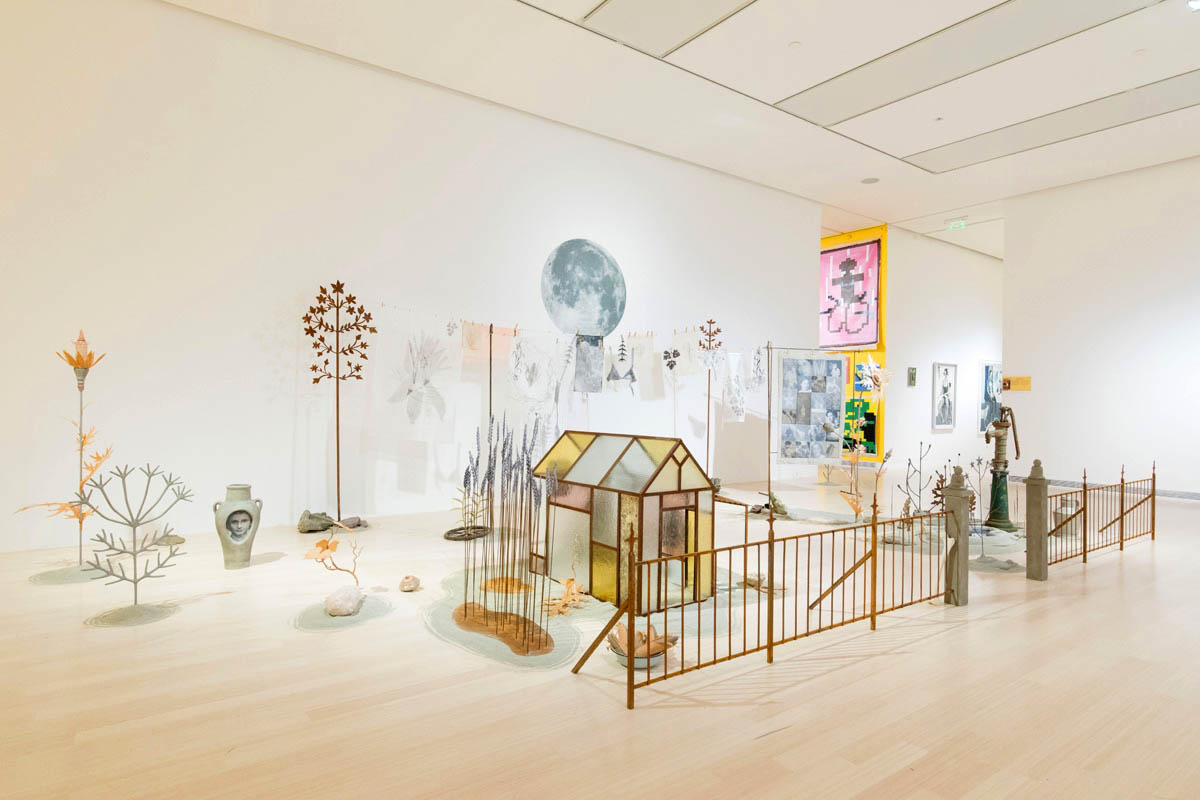
Rich yellow walls welcome me into the generous exhibition spaces of the Ludwig Museum in Budapest. The vibrant colour on some of the walls guides my gaze further into the exhibition space, drawing attention to the successive rooms. It encourages an understanding of the depth and distance between the rooms, increasing the perception of the three-dimensionality of the space. A paratextual curatorial decision that imbues the exhibition with an additional atmospheric dimension beyond the artworks themselves: against all odds, contemporary art flourishes.
Out of 262 applications, the exhibition connected to the Esterhazy Art Award 2023 has selected 18 positions highlighting the work of young Hungarian artists. A celebration of the variety, diverseness, and vibrancy of the country’s art scene. Yet, the exhibition remains personal; a walk through materials, media, memories. This layer of intimacy seeps through in the most different places: quotes in the exhibition booklet offer additional personal insights into the artwork’s background and ground the artists’ own thoughts.
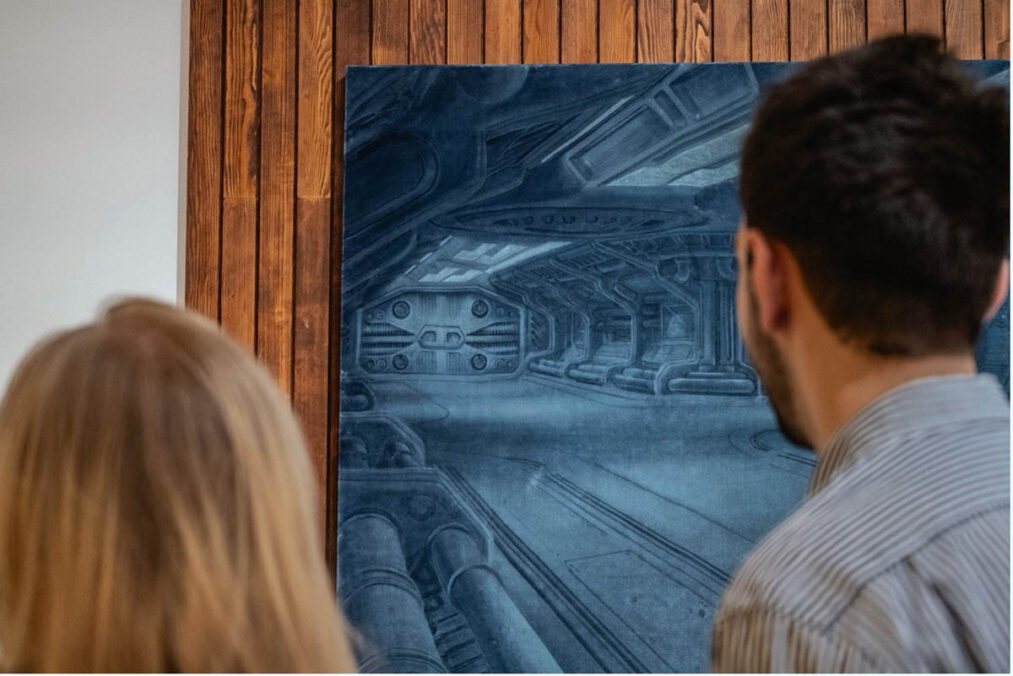
This is indicative of the careful curatorial strategy led by Vitus Weh and his team. In the lead-up to the exhibition, they visited all artists in their studios, closely collaborating to select the works to be showcased. Additionally, subtle adjustments to the presentation of the works were implemented. Especially Rita Süveges’s oil paintings on soft velvet come to mind, which are displayed on wood panels that mimic the setup in the artist’s studio. A lingering smell of oil colour mixed with soft, earthy scent of the wood draws you into the intricate monochrome paintings. The subtle sensory input provided by these smells feels like a dynamic presence, makes it seem as if the artworks had just settled into their spaces moments before anyone had entered.
Strolling through the many rooms of the exhibition, a variety of such subtle smells catch my attention, quietly urging, pulling. Smell is a powerful vehicle for memories, for nostalgia. It can subconsciously unbury year-old memories – perhaps those of our grandfather’s workspace in the cellar, one first excavated then built with five pairs of bare hands and occasionally perhaps the neighbour’s horse (if it wasn’t needed there). Or a time during our childhood when we first strolled through wide, endless seeming fields, imagining all sorts of fantastic creatures lingered within the tall grass.
Through and through, smell is a peripheral sense when it comes to engaging with art. But it is exactly the marginality of smell that intrigues here, from the oils and wood to ceramics and stone to the beeswax used in Gideon Horváth’s sculptures.
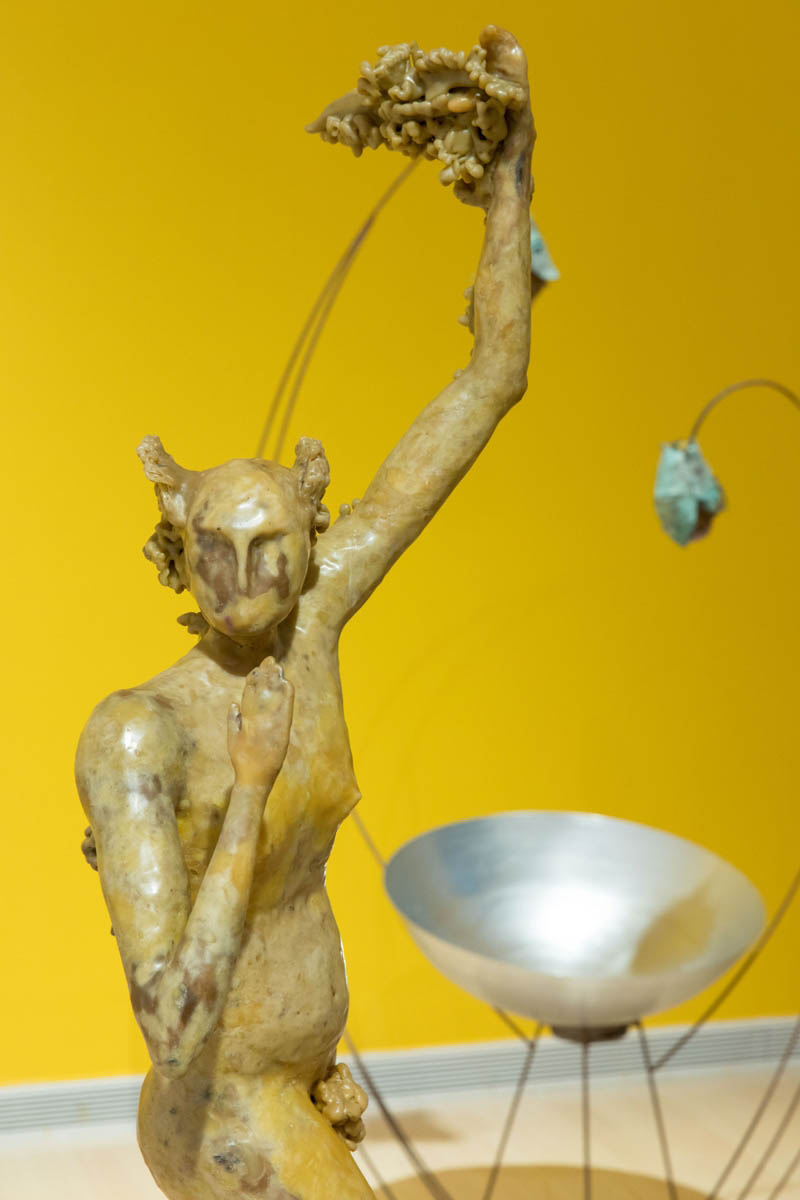
Turning away from one piece and towards the next, the yellow walls on the opposite sides of the rooms come into view again. Although initially conspicuous and attention-drawing, they subtly contribute to the overall cohesion of an otherwise diverse exhibition. The presented works span a range of media, including multimedia painting, digital art, installation, sculpture, and pencil drawing.
The common conceptual thread binding these diverse works together is articulated in the exhibition title: “Breaking the Frame” – and all the artworks indeed break the frame in various ways. Scenic installations such as that by the artistic duo awarded as winners, Karina Mendreczky and Katalin Kortmann-Járay titled “Where Have All the Flowers Gone?” or Sari Ember’s “All is Disapperaing” clearly illustrate how these works transcend traditional boundaries. In other instances, the “breakage” is more subtle, as seen in Gábor Pap’s large-scale multimedia paintings, for each of which he crafts individual canvases that deviate from the typical rigid rectangular shape.
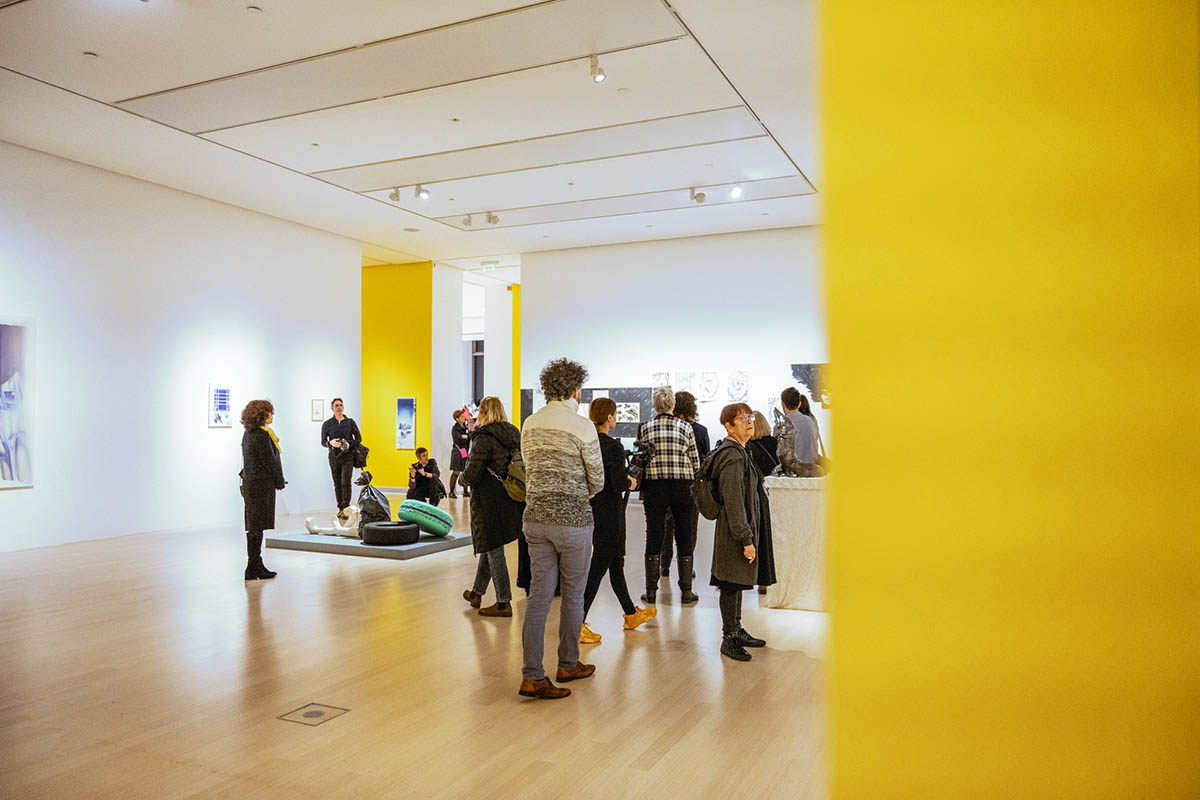
In contrast, Erik Tollas’ work exists without frames altogether, presented as collages of colour and form hanging on the wall. Here, the form of the work is not dictated by a frame or canvas at all but is solely dependent on the materials used – or rather reused, as the artist assembles his works from leftovers of the film industry. Similarly, “Songs of the Soil” by Dániel Bernáth integrateS fragments from the artists’ earlier work into his new pieces, cutting up his old canvasses to provide a new purpose for them in his newer works.
Reflecting on these works and the exhibition concept, I am reminded of a German phrase, “den Rahmen sprengen”, which translates to “to explode the frame” in English. The idiom denotes, essentially, the notion of going beyond the scope of something, and thus being unnessarily abundant or even unattainable. As such, the idiom tends to have a negative meaning. In some ways, one might argue that an exhibition that showcases all kinds of media, formats, styles topics, and ideas potentially risks pushing the limits of what can be a coherent exhibition concept, crossing the fine line of inspiration and over-exaggeration. But this is not the case.
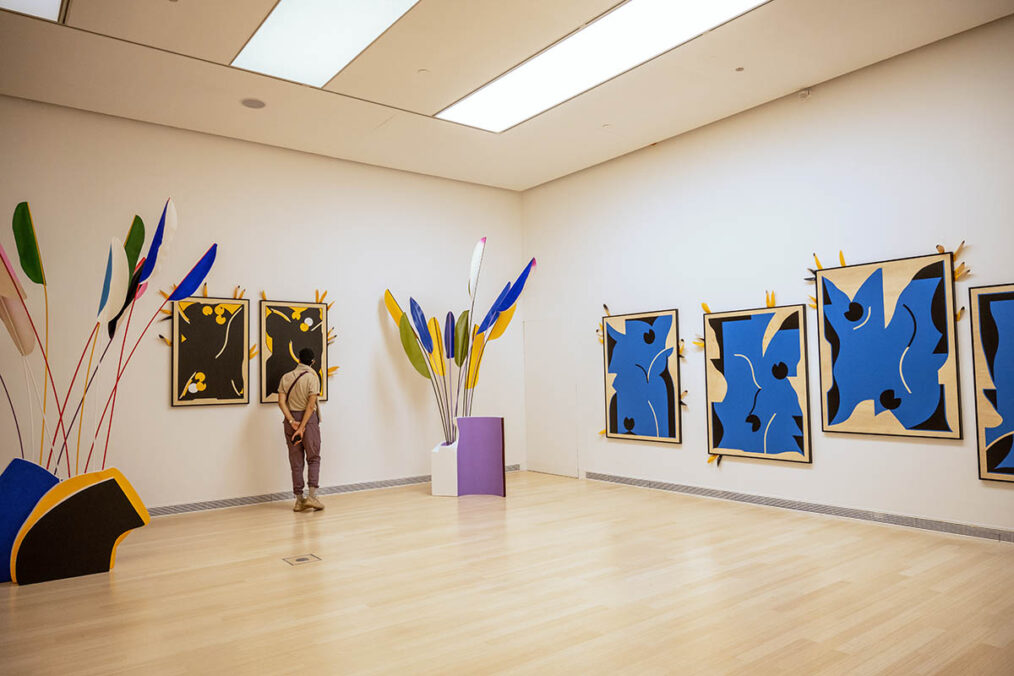
Not only does the art presented break its traditional frames, but so does the exhibition. It breaks the frame of what would perhaps usually be exhibited in a single exhibition, and revels in the diversity instead. And again, I arrive at those initial thoughts: against all odds, contemporary art flourishes. Arrive at the realization that what is shown here loud and proud is the abundance of artistic production, the promise that young artists will continue to challenge boundaries, produce new works, new perspectives, futures. In embracing the idiosyncrasies each position encompasses, the exhibition breaks free from the constraints of a singular narrative, instead offering multitudes. A quality that suits both the evident richness of artistic production and the broader demands of the times we inhabit.
The exhibition is on show until March 3rd. For those that unable to make the journey to Budapest, there will be an opportunity to see the four winning artistic positions in a subsequent exhibition in Eisenstadt, Austria.
Exhibition: Breaking the Frame – Making Future Esterházy Art Award 2023
Duration: 15.12.2023-03.03.2024
Curator: Vitus WEH (Now Esterhazy Contemporary)
Artists / Nominees: BEDE Kincső, BERNÁTH Dániel, BIRKÁS Mona, EMBER Sári, GALLOV Péter, HORVÁTH Gideon, KIRÁLY Gábor, KIS RÓKA Csaba, KRISTÓF Gábor, LŐRINCZ Áron, MENDRECZKY Karina – KORTMANN-JÁRAY Katalin, OLÁH Norbert, PAP Gábor, PINTÉR Gábor, SÜVEGES Rita, TOLLAS Erik, TRAPP Dominika, VÉKONY Dorottya
Jury members: DR. FABÉNYI Julia @juliafabenyi, Dr. Ulrike GROOS @ulrikegroos, Barbara HORVATH @babshorvath, RIEDER Gábor @riedergabor, DR. OTTRUBAY István, SZEGEDY-MASZÁK Zsuzsanna, PhD, Vitus WEH
Address and Contact:
Ludwig Museum Budapest
Komor Marcell u. 1, 1095
www.ludwigmuseum.hu
www.instagram.com/ludwigmuseum/
In 2009, the Esterhazy Private Foundation established the Esterhazy Art Award through Dr. Stefan Ottrubay. The award is an updated continuation of the artistic patronage pursued by the Princess Esterházy over four centuries. The exhibition, which has become the most important overview of the art scene of young Hungarian talent, is held every two years at the Ludwig Museum in Budapest. The prize itself is worth €5,000 and is awarded to up to three artists by an internal jury. The aim is to promote the greatest talents and their cross-border exchange.




